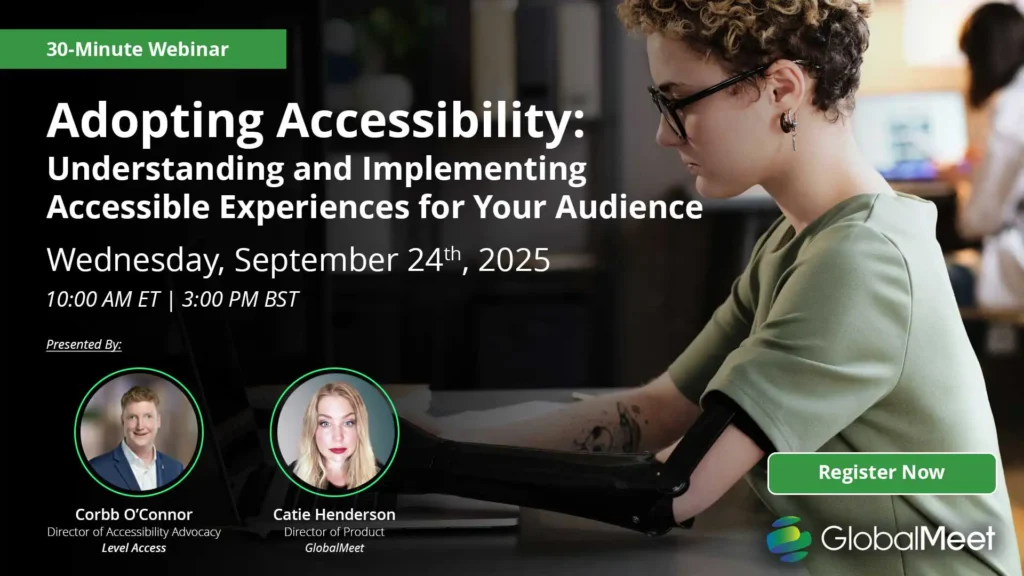
Microlearning in Virtual Events: Short Sessions for Improved Retention
- by GlobalMeet Blog Team
- ,
In the digital world attention is a scarce commodity. Social media, shortform video, and the ability to find information in a matter of seconds have left attention spans dwindling and engagement harder than ever.
This shift is having a significant impact on the many organizations that rely on virtual events for Continuing and Professional Education. Long, drawn out presentations are giving way to short, bite sized microlearning formats that keep attendees engaged for longer and support better knowledge retention.
What is Microlearning?
Microlearning is an educational approach that prioritizes delivery in short, focused bursts rather than longer sessions. The average microlearning session lasts 3-10 minutes, with a priority on easily digestible and memorable content. With information broken into smaller, structured modules this method of learning has proven particularly effective for remote learning environments, virtual conferences, and digital training programs.
The Science Behind Microlearning
Attention Spans are Shrinking
With the rise of smartphones and social media, the average human attention span in the last twenty years has shrunk from 2.5 minutes to 45 seconds. This significant drop in attention is making it harder than ever to engage virtual audiences via traditional learning methods, and is encouraging organizations to transition to alternate formats.
Utilizing the Ebbinghaus Forgetting Curve
One of the key theories behind the science of Microlearning is the Hermann Ebbinghaus Forgetting Curve. Ebbinghaus studied memory decay without reinforcement, and discovered that:
- 50% of information was forgotten after one day
- 90% of information was forgotten after one week
Combined with the audience memory curve, which suggests that audience attention peaks at the beginning and the end of a presentation, while dipping in the middle, it become clear that traditional methods are no longer suitable for modern audience.
Microlearning helps to counteract this information loss and anchor information into long term memory by delivering information in short segments and building in regular reinforcement through quizzes, polls and recaps.
The Benefits of Microlearning
Flexibility and Convenience
One of the biggest strengths of microlearning is its flexibility. Learners can consume content at their own pace, on a schedule that works best for them. For continued professional education events that span multiple time zones, microlearning modules offer an accessible, convenient learning experience that increases the chance of core objectives being fulfilled.
Learner Preference
Modern learners, especially younger professionals, express a preference for shorter formats. With the rise in popularity of shortform content in both video and text platforms, the preference in training has also shifted to mirror these trends. Microlearning satisfies the desire for shorter content, aligning professional development with the technological standard.
Cost-Effective and Scalable
The benefits of Microlearning aren’t just for learners. Even for the most experienced teams developing long-form training content can be both expensive and time-consuming. Microlearning modules are typically easier to produce, update, and repurpose when compared to their longer form counterparts, which can increase their overall ROI.
Best Practices for Structuring Microlearning Content
Creating microlearning content takes more than chopping up existing materials into smaller segments. To make the most impact with microlearning content you should:
- Stick to one objective per module: Keeping focus on a single learning objective will make the content easier to absorb and remember.
- Use a variety of media formats: By using a mix of short videos, infographics, speakers, and slides, you can improve retention and cater to a range of learning styles.
- Make use of interactive elements: Tools like polls and quizzes can encourage participation and reduce screen fatigue.
- Incorporate storytelling: Incorporating case studies and scenarios in a narrative arc is a great way to create engagement.
- Reinforce and repeat content: Revisit key points multiple times through the session in different ways to boost retention.
Implementing Microlearning in Virtual Events
Enterprise grade virtual event platforms are making it easier than ever to implement microlearning techniques into virtual events. With integrated engagement and analytics features, and customizable portals to keep everything in one place, the right platform can transform your CPE approach.
But the right platform alone isn’t enough without implementing the principles of microlearning.
Build in Recaps
Rather than delivering content in one long session, break it down into short segments with recaps and key takeaways built in. Adding polls and Q&A sessions can also help to reinforce learning and create an active learning environment.
Intermittent Testing
Instead of saving assessments for the end of a course, adding knowledge checks at the end of each segment provides instant feedback and supports active learning.
Mix Video Clips and Live Speakers
Changing content format through the course of a session can also boost engagement. Using a mix of pre-recorded videos and live speakers, with supportive infographics and dynamic slides can also reduce mental fatigue, leading to better outcomes overall.
Schedule Short Breaks
Planning in short, timed breaks between content segments is vital. These can be simple comfort breaks for learners to fresh themselves, or guided sessions that encourage mindfulness and wellbeing exercises to reset focus.
Conclusion
Microlearning isn’t a passing trend, but an evidence-based answer to modern learning challenges. When implemented well, microlearning can turn passive CPE broadcasts into dynamic learning sessions that support continuous professional development objectives and individual learning styles.
With the continued trend of content getting shorter, and attention spans shrinking with it, event planners should also be thinking short. By using microlearning strategies you can help virtual audiences stay engaged, retain information, and get more out of your CPE events.

